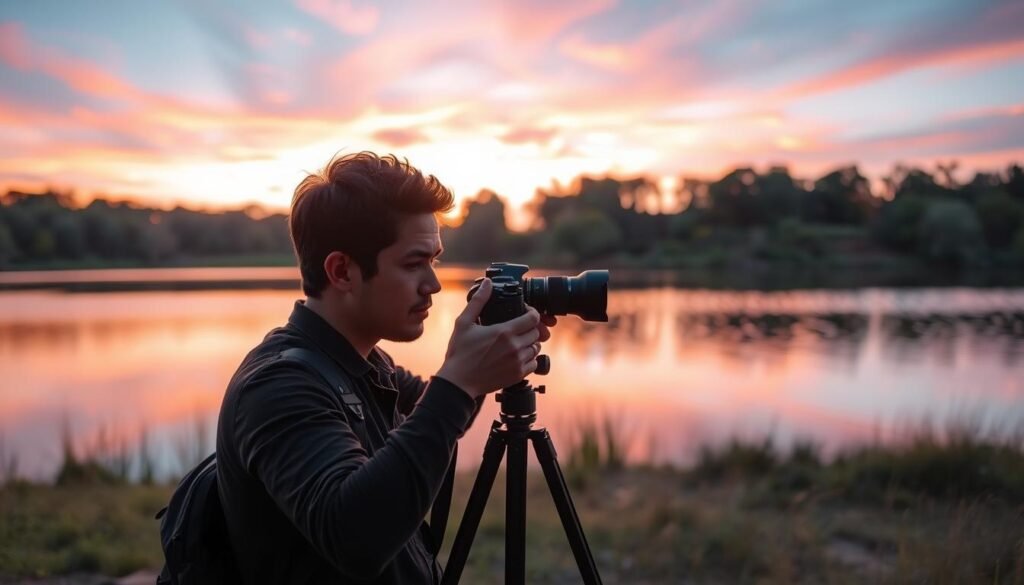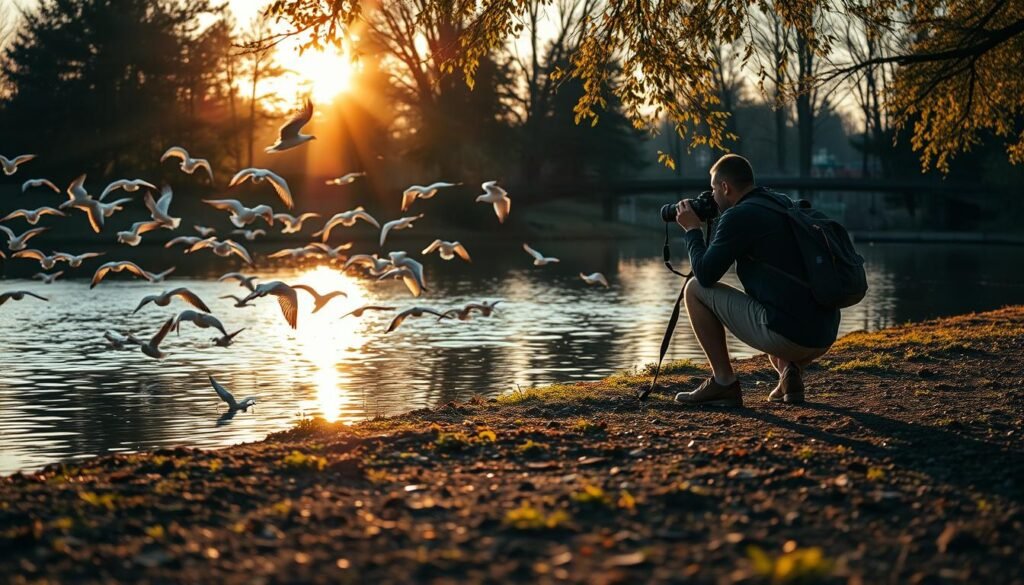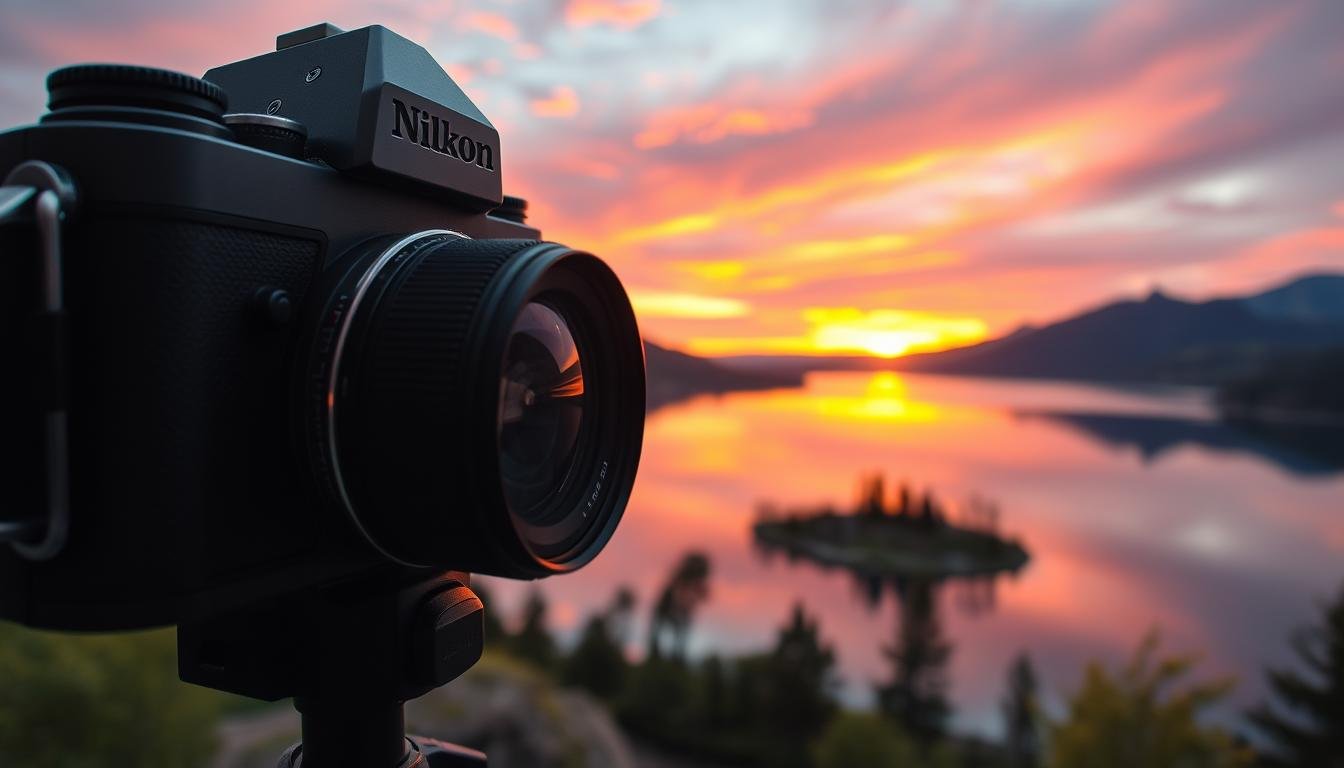In photography, catching the perfect moment is about timing and arranging things. This guide will share key tips to help photographers catch and hold onto brief but essential moments. Photographers can make ordinary scenes into unforgettable pictures by knowing how to wait, use their skills, and see things creatively.
Key Takeaways
- Tapping into the power of timing is crucial for memorable photography.
- Master the “golden hour” for optimal natural lighting conditions.
- Understanding motion techniques, like freezing action or creating motion blur, adds depth to images.
- Reading and utilizing natural light enhances photographic outcomes.
- Effective composition, such as the rule of thirds, leads to aesthetically pleasing photos.
- Incorporating leading lines and symmetry guides the viewer’s eye through the photograph.
- Utilizing negative space helps focus on the main subject, adding a creative touch.
The Importance of Timing in Photography
Getting the perfect shot is all about timing. You need to know when to take your photos. Let’s explore some tips to improve your photos.
Understanding the Golden Hour
The golden hour is unique. It occurs right after sunrise or before sunset, and the sun’s low light makes everything look warm and soft.
This light is great for photos of people and places, but it doesn’t last long, so you must plan carefully to capture it.
Freezing Motion vs. Intentional Blur
There are two main ways to take photos: freezing motion and intentional blur. Freezing motion uses a fast shutter speed. It makes moving things look still.
Intentional blur, on the other hand, uses a slow shutter speed. It shows movement and adds life to your photos.
| Technique | Purpose | Shutter Speed | Applications |
|---|---|---|---|
| Freezing Motion | Captures sharp images | Fast (1/1000s or faster) | Sports, wildlife |
| Intentional Blur | Conveys movement | Slow (1/30s or slower) | Landscape, conceptual art |
Reading Natural Light
Natural light is very important for photographers. It can add mood and depth to your photos. It is crucial to know how to use it, whether it’s bright or soft.
Pay attention to the light’s quality, direction, and color. Adjust your camera settings to get the best results.
Focusing on timing can make your photos more beautiful and emotional.
Mastering Composition in Photography
Getting great photos is all about composition. Knowing the rule of thirds, leading lines, symmetry, and negative space make photos pop.
The Rule of Thirds Explained
The rule of thirds is key to mastering composition in photography. It divides the frame into a nine-part grid. Place your subject on these lines or where they meet for better photos.

Leading Lines and Symmetry
Leading lines are important in mastering composition in photography. They lead the viewer’s eye, adding depth. Think of roads, rivers, or buildings that lead to your subject. Symmetry brings balance and beauty, like in reflections or buildings.
Using Negative Space Effectively
Negative space is the empty area around your subject. Using it well makes your subject stand out. It’s great for simple photos where the subject shines against a clean background.
Using the rule of thirds, leading lines, symmetry, and negative space can make photos more artistic and powerful.
Capturing the Perfect Moment: A Photographer’s Guide to Timing and Composition
Timing and composition are key in photography. They work together to create amazing pictures. This tutorial on capturing perfect moments will help you improve your skills in these areas.
One big trick is knowing the “decisive moment.” Henri Cartier-Bresson said it’s when everything in the picture is just right. This makes the photo tell a story or show a feeling.

Good composition is also vital. It’s about how you arrange things in the picture. Rules like the rule of thirds help make the photo look good. When you mix timing with these rules, your photos tell a story.
Here are some steps to get better at timing and composition:
- Anticipate the Moment: Watch your subject and setting to guess when something big will happen.
- Use Continuous Shooting Mode. This lets you take many photos simultaneously, helping you catch the perfect shot.
- Experiment with Angles: Try different views to make your photos stand out.
- Follow the Light: Natural light changes how your photos look. Pay attention to where and how strong it is.
Here’s a look at some key ideas for capturing perfect moments:
| Aspect | Description | Impact |
|---|---|---|
| Decisive Moment | Shutter pressed at the peak of action or emotion | Enhances storytelling and emotional impact |
| Rule of Thirds | Placing subjects along imagined gridlines | Creates dynamic and engaging compositions |
| Leading Lines | Using lines to guide the viewer’s eyes | Draws attention to main subjects effectively |
In short, timing and composition are crucial. You can make photos that touch people’s hearts using the right timing tricks and composition techniques.
Expert Photography Advice for Capturing the Moment
Photography is about capturing a moment, setting the scene, and connecting with your subjects. Even though knowing your camera is important, people make photos come alive. Annie Leibovitz and Steve McCurry share tips to make your photos stand out.
Setting the Scene
Starting with a great scene is key. Look around to see the light, background, and mood. Details matter a lot. A messy background can ruin your photo.
Think about Ansel Adams. He planned his shots carefully. This made his photos of nature amazing.
Engaging with Subjects
Connecting with your subjects is just as crucial. You need to get real expressions and poses. Start by building a rapport and making them feel at ease.
Brandon Stanton of Humans of New York does this well. He spends hours with people to capture their true selves, and trust is what makes a photo-real.
FAQ
What are some essential photography tips for beginners?
Start with the basics of composition. Learn about the rule of thirds and leading lines. Also, use negative space well.
Practice during the golden hour to improve your photos.
How does one master timing in photography?
Master timing means knowing the golden hour and natural light. Decide when to freeze or blur motion.
Practice often to predict and capture moments well.
What is the rule of thirds, and why is it important?
The rule of thirds divides an image into nine parts. Place subjects at intersections or lines for balance.
This makes photos look good and balanced.
How can I use natural light to my advantage?
Use the golden hour for soft, warm light. Learn how light affects your subject.
Use natural light sources like windows for mood and depth.
What are some of the best composition techniques?
Key techniques include the rule of thirds and leading lines. Symmetry and negative space also work well.
Knowing these basics improves your photos’ visual impact.
What is the difference between freezing motion and intentional blur?
Freezing motion uses fast shutter speeds for sharp images. Intentional blur uses slow speeds for movement.
It shows action in photos.
How do I engage with subjects to capture authentic moments?
Build rapport and make subjects comfortable. Talk to them and give clear directions.
Keep the environment relaxed for natural shots.
What role does negative space play in composition?
Negative space isolates and emphasizes subjects. It adds balance and focus to photos.
It can also set a mood or highlight parts of your composition.
What are some photography timing tricks for capturing the perfect moment?
Anticipate action and use burst mode for fast shots. Practice at different times to understand light and timing.
How do I effectively set the scene for a perfect shot?
Think about the background, lighting, and subject placement. Make sure the background doesn’t distract.
The light should highlight important elements. Place the subject according to your chosen technique.

